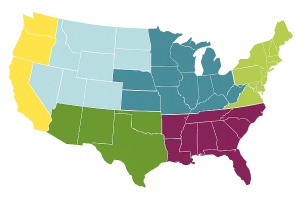Late Fall and Winter Planting Times
Posted By American Meadows Content Team on Sep 27, 2012 · Revised on Oct 13, 2025

Knowing your location helps us recommend plants that will thrive in your climate, based on your Growing Zone.
Posted By American Meadows Content Team on Sep 27, 2012 · Revised on Oct 13, 2025
This is a big country, with all kinds of climates from coast to coast with widely varying planting dates for seeds, bulbs, and plants.
In the Northeast and Midwest, the ground freezes solid during November and December, while on most of the West Coast freezes are rare all winter long. For gardeners in much of the South and Southwest, there is no frost at all. In simple terms, for a new gardener, it can be challenging to figure out - when is the best time to plant?
Across the country, planting isn't just for spring! Late fall and winter can offer very productive planting times - read on for a few tips about what will work in your area.
We at American Meadows, and many other sources ship Daffodils, Tulips and other fall-planted bulbs from August into November. There are 2 important things to remember about planting Fall-Planted Bulbs:
Remember, nature plants wildflower seeds in the fall and winter, when ripened seeds rain down from last summer's flowers, the natural cycle is renewed.
In The Northeast, Midwest, and the Rockies: For hard winter areas, fall means a dormant planting of seeds. This means that after a killing frost, you put down your seed the same way you'd do in spring. This can be done anytime before your ground freezes. Fall planted seed is up and in bloom about two weeks earlier than the same seed planted in spring.
In Frost-Free Areas with hot summers: If you have no frost at all (So. Florida, extreme Southern Texas, and much of the southwest and southern California), you can plant almost all winter. In frost-free areas where the summer heat is intense (Southwest deserts, South Florida), your best planting time is during fall for winter bloom, so you'll have good bloom before your inevitable "burn-out" once summer begins.
California: We recommend planting wildflower seeds beginning in October, and continuing on into January. It's always best to plant just before your rainiest season begins.
The South: Your wildflower seed planting method is the same as the Northeast, except you have much less time to wait for your spring sprouting and summer bloom. As long as you have had frost (when the tomatoes and impatiens are dead from the cold), you can do a "dormant" planting of wildflower seed anytime. Whether your ground freezes or not, your seed will sprout and begin to grow as soon as your soil warms in spring.
We ship our bare root and potted perennials from August into October. Cooler fall temperatures are ideal for establishing new perennial plants - especially in warmer climates! In colder climates, it's best to plant perennials a few weeks before a hard frost, so they can establish roots before going dormant for the winter.
We're here to help! Contact Us.